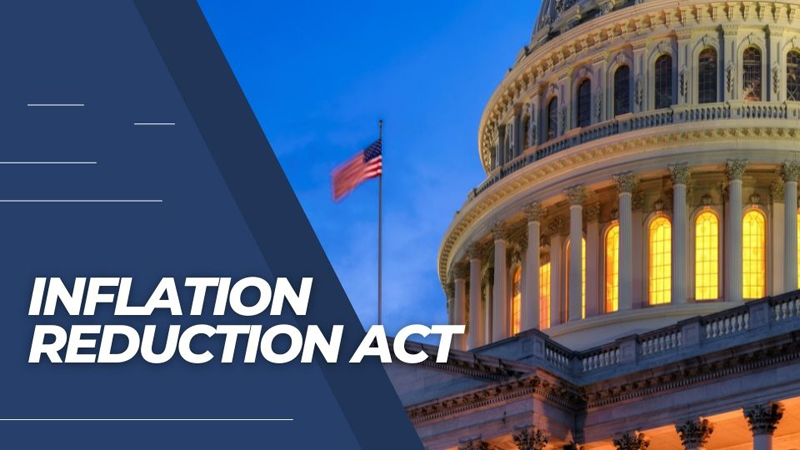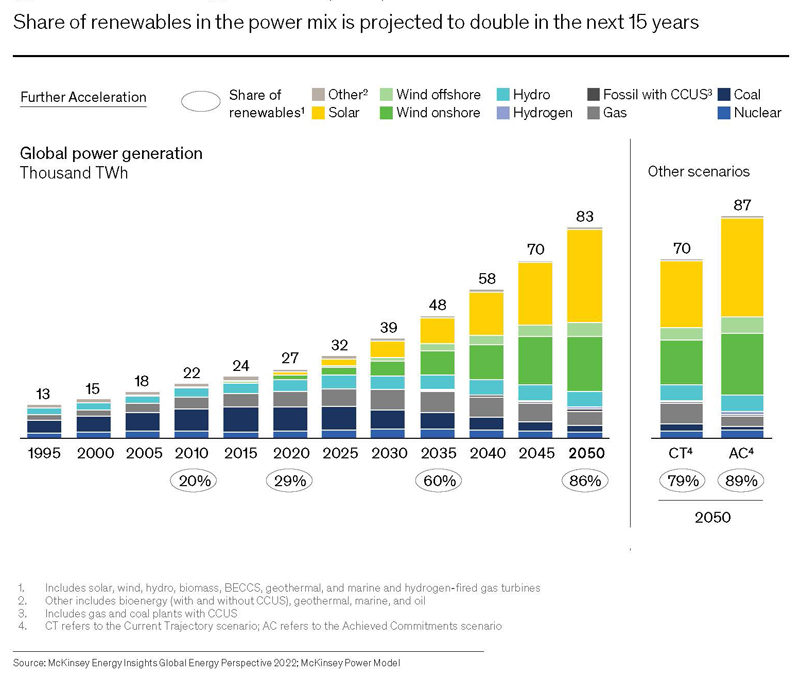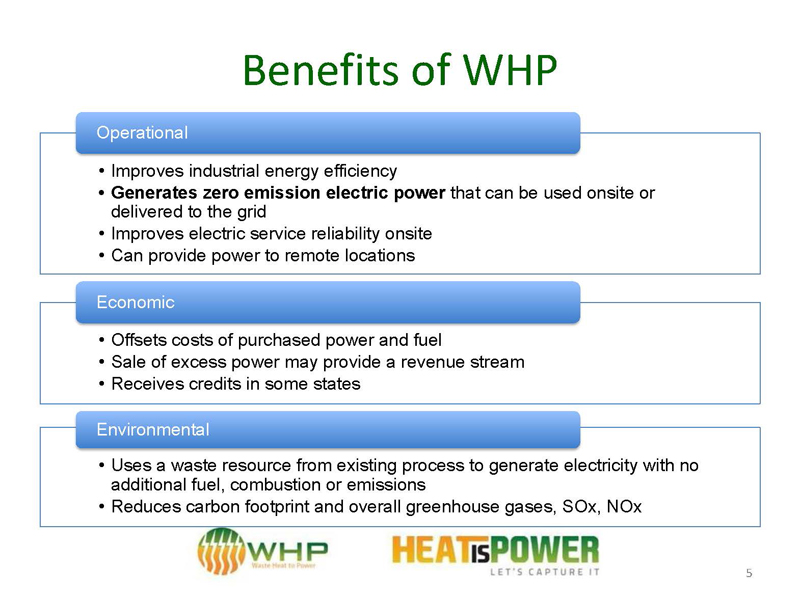AT LAST! MAJOR CLIMATE LEGISLATION IN THE U.S.
Biden signs landmark bill to accelerate energy transition

“The Inflation Reduction Act is a clean-power policy behemoth that [will] lower energy prices, benefit consumers with more clean energy choices, and provide a path to cut U.S. carbon emissions 40 percent below 2005 levels by 2030.” Eric Wesoff – Canary Media
According to Eric Wesoff of Canary Media, “The Inflation Reduction Act is a clean-power policy behemoth that [will] lower energy prices, benefit consumers with more clean energy choices, and provide a path to cut U.S. carbon emissions 40 percent below 2005 levels by 2030.” The bill includes $369 billion over ten years to support for clean energy and a stable climate, and represents the largest climate investment in U.S. history.
Broad provisions
As summarized by Bloomberg, provisions focused on clean energy deployment and manufacturing include “tax credits of up to $7,500 for the purchase of a new electric vehicle and $4,000 for lower- and middle-income families who purchase a used EV; $60 billion of incentives to accelerate U.S. manufacturing of solar panels, wind turbines and batteries, and critical minerals processing; and tax credits for consumers who add renewable energy features such as efficient heat pumps, rooftop solar, electric HVAC and water heaters to their home.”
For the first time, investment tax credits are available for stand-alone energy storage investments, ranging from battery projects to thermal energy storage systems. Per Jeff St. John, also of Canary Media, “To date, only batteries being directly charged by solar installations have been eligible for [tax credits], limiting federal tax policy support for a technology that’s seen as central to integrating variable wind and solar power into the grid.” The bill would also offer credits to technologies including microgrid controllers and new linear generators that can run on low- or zero-carbon fuels.
We’re thrilled at this major step toward the United States doing its part in mitigating climate change. Read a message from our CEO, 40-year environmental activist and solar energy pioneer Bruce Anderson, below.
THE BIG PICTURE — LONG-TERM GLOBAL ENERGY INSIGHTS FROM McKINSEY
 Short-term-turmoil in energy markets makes it easy to lose sight of long-term trends — both positive and negative — that must inform energy planning and investment decisions today. Global consultancy McKinsey’s recent Global Energy Perspective 2022 report looks ahead to project the development of fundamental drivers for the global energy system and offers an outlook for a full spectrum of power systems and related applications.
Short-term-turmoil in energy markets makes it easy to lose sight of long-term trends — both positive and negative — that must inform energy planning and investment decisions today. Global consultancy McKinsey’s recent Global Energy Perspective 2022 report looks ahead to project the development of fundamental drivers for the global energy system and offers an outlook for a full spectrum of power systems and related applications.
Renewables at the forefront
Of greatest interest to us, of course, is the renewables sector, where the bulk of progress toward global decarbonization targets will need to be made. Driven by the need to electrify as much of humanity’s powered activities as possible, McKinsey projects that overall global power consumption is expected to triple by 2050.
The lion’s share of this growth will of necessity be met by renewables – in particular solar and wind. Says McKinsey, “Renewables are expected to become the new baseload, accounting for 50% of the power mix by 2030 and 85% by 2050.” Further, “Renewable generation is projected to reach 80–90% of the global energy mix by 2050 as the global build-out rates for solar and wind grow by a factor of five and eight respectively.”
Green hydrogen emerges
Fixed sources of power are fine for fixed activities, but 25% of global energy consumption is used to move people and goods via road transport, maritime shipping, and aviation (source: EIA). Decarbonizing the transportation sector will require clean, renewable, transportable sources of power, and hydrogen is emerging as the fuel of choice. However, at present, so-called grey hydrogen (made processes powered by fossil fuels) dominates hydrogen production. This is expected to change as McKinsey projects hydrogen supply to shift from nearly 100% grey hydrogen today to 60% clean production as early as 2035 and 95% by 2050.
Green hydrogen — produced by electrolysis powered by clean energy — is expected to proliferate rapidly as economics improve, driven by scalable, round-the-clock clean power technologies (like ours) that enable electrolyzers to operate day and night.
Investment Outlook
McKinsey’s report explores five scenarios centered around the pace of technological progress and level of policy enforcement and projects the impact of each on the mitigation of climate change. On the world’s current trajectory, global temperature increase is expected to reach 2.4℃ by 2100, far short of the Paris target of 1.5℃. McKinsey believes this is likely to motivate further acceleration of the energy transition driven by increased investment and new, country-specific commitments.
Overall, according to the report, “Annual investments in energy supply and production are expected to double by 2035 to reach $1.5 trillion to $1.6 trillion; almost all growth is expected to come from decarbonization technologies and power, which by 2050 will exceed today’s total energy investments.”
Read more of McKinsey’s report here.
WASTE HEAT TO POWER – AN UNREALIZED OPPORTUNITY
 Did you know that 30% of all energy in the US is consumed by industry, and 20-30% of that consumption is lost as waste heat? Moreover, most industrial process heat today is produced by fossil fuels. This represents a huge opportunity, as technology now exists to turn this waste heat into emissions-free electricity.
Did you know that 30% of all energy in the US is consumed by industry, and 20-30% of that consumption is lost as waste heat? Moreover, most industrial process heat today is produced by fossil fuels. This represents a huge opportunity, as technology now exists to turn this waste heat into emissions-free electricity.
Last month we were fortunate to attend a webinar on Net Zero Heat, under the auspices of the LDES Council in collaboration with the Heat is Power Association. Among other topics, the presenters discussed the operational, economic, and environmental benefits of harnessing industrial waste heat to produce power (WHP).
Many WHP solutions operate at relatively low temperatures, generating electricity with steam turbines. 247Solar’s Heat2Power™ turbine operates at the high-temperature end of the spectrum (>850℃), where it uses exhaust from thermal oxidizers and other high-temperature sources directly to produce electricity from industrial processes that are otherwise hard to decarbonize.
Click here to learn more.
NEWS FROM 247SOLAR
CEO Bruce Anderson’s statement on this week’s climate legislation

247Solar Founder and CEO Bruce Anderson.
This week, after 50 years of baby steps on climate change, the United States took a major leap for mankind when President Joe Biden signed the Inflation Reduction Act into law. While many may grumble that this legislation is ‘not as good as it could be,’ today we at 247Solar choose to celebrate it as an important step forward.
Read Bruce’s full statement here.
FOLLOW & JOIN 247Solar
LinkedIn, Twitter, YouTube, Whatsapp
Contact: info@247solar.com